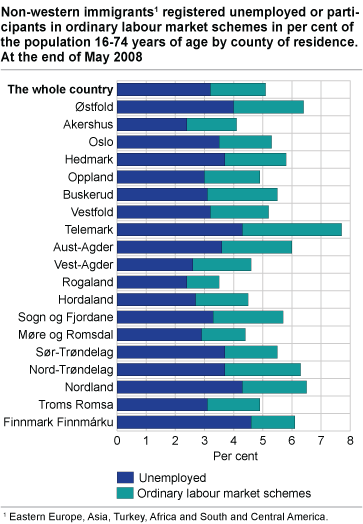Content
Published:
This is an archived release.
Immigrant unemployment halved in three years
Registered unemployment among immigrants was 4 per cent in May 2008 versus 9.7 per cent in May 2005. In the whole of the population, registered unemployment fell from 3.3 to 1.5 per cent during this period.
9 388 immigrants were registered unemployed in the second quarter of 2008, a decline of 617 from the corresponding quarter last year when the unemployment rate was 5 per cent. On the contrary there has been some increase in the number of immigrants on ordinary labour market schemes of. Thus the number of the gross unemployed (i.e. registered unemployed + participants on ordinary labour marked schemes) was almost unchanged at 14 500 in both quarters. But since the number of immigrants in the labour force has expanded quite a lot during the last year, we can also see a fall in the gross employment rate at 1 percentage point.
|
Immigrants are defined as being born abroad by foreign-born parents. They must be registered as settled in Norway for at least six months. The figures are based on the Directorate of Labour's register of job seekers and are calculated as a fraction of the labour force. Descendants are defines as Norwegian- born by foreign born parents (i.e. immigrant- parents). |
Largest decline among the Africans
Immigrants from Africa had the largest decline in unemployment since the second quarter last year, down 1.6 percentage points. This group still has the highest unemployment rate at 9.5 per cent. Immigrants from Asia had the second highest rate at 5.6 per cent, while the unemployment rate for immigrants from Eastern Europe (except EU countries) and South and Central America was 4.8 per cent and 3.9 per cent respectively. Immigrants from western regions had an unemployment rate slightly below 2 per cent, while 2.1 per cent of the immigrants from the EU countries in Eastern Europe were unemployed.
Slightly higher unemployment among women
The unemployment rate for male and female immigrants was 3.9 per cent and 4.2 per cent respectively. In the rest of the population, the unemployment rate was 1.3 and 1.1 per cent for men and women. This is contrary to traditional gender differences in registered unemployment among immigrants where men usually have a higher unemployment rate than women. This new pattern is probably due to an increase in female job seekers caused by the more favourable labour market conditions today.
Few descendants registered unemployed
Only 282 descendants, defined as people born in Norway by foreign-born parents, were registered unemployed in May 2008. The majority were aged 16-29 years, and in this group the unemployment rate was 2.3 per cent, which was almost at the same level as the corresponding age-group in the population as a whole.
Participants on labour market schemes slightly increased
Despite the falling unemployment rate, there was a slight increase in the number of immigrants on ordinary labour market schemes (job programmes) from 4 520 in May 2007 to 5 164 in May 2008. In total, 13 000 people participated in labour market schemes. Also among participants in the majority population, there was a slight increase of 375 participants.
As a percentage of the immigrant population, the participation rate increased slightly from 1.4 per cent in May 2007 to 1.5 per cent in May 2008. In the rest of the population, the participation rate rose from 0.2 to 0,3 per cent during this period. Immigrants from Africa had the highest participation rate at 3.6 per cent in the second quarter this year.
Tables:
- Table 1 Registered unemployed by immigrant background, region of birth and sex. In absolute figures and in per cent of the labour force. By the end of May 2007 and 2008
- Table 2 Participants on ordinary labour market schemes (job programmes) by immigrant background, region of birth and sex. Absolute numbers and in per cent of persons aged 16 to 74 years. By the end of May 2007 and 2008
- Table 3 Registered unemployed by region of birth and time of residence in Norway. By the end of May 2007 and 2008. Absolute figures and in per cent of persons in total aged 16-74 years
- Table 4 Registered unemployed by immigrant background, region of birth and county of residence. Absolute numbers and in per cent of persons aged 16 to 74 years in each group. By the end of May 2007 and 2008
- Table 5 Participants on ordinary labour market schemes (job-programmes) by immigrant background, region of birth and county of residence. Absolute numbers and in per cent of persons aged 16 to 74 years in each group. By the end of May 2007 and 2008
- Table 6 Registered unemployed by sex, immigrant background, region of birth and age. Absolute numbers and in per cent of the labour force. By the end of May 2007 and 2008
Additional information
The unemployment figures are based on the Norwegian Labour and Welfare Organisation’s register of jobseekers and are calculated as a share of the labour force, which is the sum of employed persons and registered unemployed persons, i.e. people offering their labour on the labour market.
Contact
-
Statistics Norway's Information Centre
E-mail: informasjon@ssb.no
tel.: (+47) 21 09 46 42

